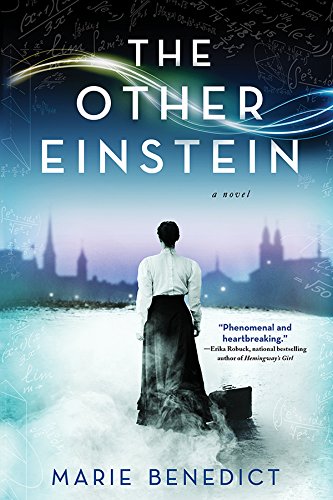Home > Book Review: The Other Einstein
Book Review: The Other Einstein

Bold or misleading?
“The Other Einstein aims to tell the story of a brilliant woman whose light has been lost in Albert’s enormous shadow — that of Mileva Maric.” — From the Marie Benedict (author) in an afterword
Marie Benedict, the author of The Other Einstein, achieves what she set out for herself. The novel integrates thin but intriguing documentary evidence about Mileva Maric with rich imaginative story-telling to create a compelling and intricate fictional biography of Albert Einstein’s first wife.
When we first meet Mileva, she is a nervous but brilliant young woman training in physics at university, an unusual accomplishment in this era, one that in itself suggests an exceptional and tenacious mind, able to overcome the masculine dominance of both society and science in her noble quest for the pure knowledge of physics. Ironically, her intellectual pursuits are enabled by a modest physical disability affecting her leg, rendering her unmarriageable in her parents’ eyes.
Her life quickly intersects with Albert Einstein, and we witness, through her eyes, a charming child-like romance rooted in a shared passion for physics. But that’s pretty much the end of her happiness, as imagined by the author. Their relationship unfolds in slow motion inevitability to its tragic conclusion—from early devotion and love to disillusioned domestic drudgery, abuse, adultery, separation and ultimately divorce. As portrayed, Mileva was perpetually in the dark about Albert’s mercurial affections, even as she risked her intellectual path and reputation to maintain the troubled relationship seeking to protect their children from the stigma of a failed marriage.
In this telling, Mileva’s promising intellect and scientific training are largely wasted, at best, and destroyed, at worst, as Albert’s scientific stature grows, accompanied by his rising arrogance and cruel indifference to Mileva. The more Mileva tries to please him with domestic servitude, the more he strays. Mileva is wronged, again and again—sacrificing everything, forced into the punishing role of an unloved spouse.
The characterization of Albert is harsh, and Mileva is portrayed as increasingly desperate, unkempt, unable to wrest control of her own life after their coupling. The truth, of course, is lost to history, but it’s an interesting story, even as it lightly echoes the stereotypical perspective that the heels of patriarchy inevitably crush women. With less deft hands, this approach has the potential to paradoxically infantilize and further victimize women but the author skirted this concern well enough.
As a telling of an unknown yet pivotally placed person in history, the book succeeds. The writing is solid, the pacing effective, and the descriptions reliably transport the reader into the past with careful attention to the details of language, custom and activities of the mid-twentieth century era. Mileva Maric is rescued from the dustbin of history.
In this way, the book falls into broader scholarly efforts to reconsider history through an inclusive lens. Women, as well as most all groups outside of white males, have largely been invisible in the telling of history. This is starting to change. Within fiction, the wildly successful The Paris Wife exemplifies the application of this trend in a narrative model; the early life and writings of Ernest Hemingway are seen through the perspective of his first wife Hadley.
But there’s a difference. The Paris Wife does not suggest that authorship of Hemingway’s early novels belonged to his wife.
“The precise nature of Mileva’s contribution to the 1905 theories attributed to Albert is unknown.” — From the author’s afterword
The foundational narrative glue of The Other Einstein is that Mileva, either independently or in collaboration with Albert, conceived the scientific ideas currently attributed solely to Albert. Further, the author contends that Albert thwarted recognition of Mileva’s contributions to these paradigm-shifting theories in collusion with the prevailing patriarchal scientific establishment.
In other words, this book does not simply present a new perspective on historical events but changes aspects of the events themselves.
Yet, there is no persuasive evidence or scientific consensus on this point, as the author states in her afterword.
Did Albert’s first wife contribute to these theories? The truth is undoubtedly forever lost in a maze of history in which women’s contributions to society, science and culture were largely repressed. Hence, uncovering reliable evidence to support the author’s assertion of scientific ownership is unlikely. This presents a conundrum. What latitude is acceptable in fiction to reconsider aspects of history when telling a story otherwise rooted in fact? Is there a point at which a story becomes veiled propaganda for an individual (or institutional) viewpoint? Does this book go too far?
Depending on one’s perspective, assigning new or partial authorship of major scientific concepts to an unknown physicist without proof is either bold or misleading. I struggled with these questions for some time, and finally landed on the side of boldness. When faced with a past in which women have been largely excluded from the historical record, what other options exist except to speculate on what might have been? Fiction provides one of the few avenues for redress.
That said, the book should be read with a healthy skepticism, given the absence of fact to back up the significant implications of the author’s assertions. I hope it is also read with an eye toward sparking discussion and possibly future scholarly activity or non-fiction undertakings on the intriguing life of “the other” Einstein.
I received a free copy of this book from NetGalley in exchange for an honest review.
